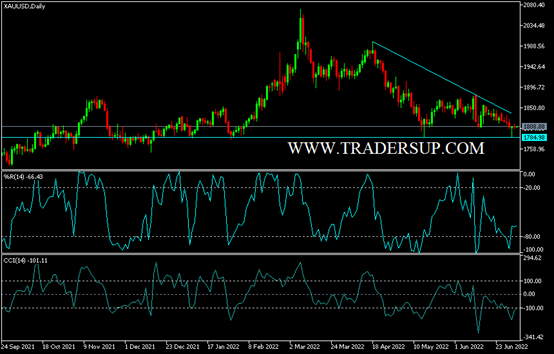With the beginning of this week's trading, the performance of gold prices varied despite the weakness of the US dollar and the recent sharp drop in US Treasury yields. The price of gold continued to move in narrow ranges, coinciding with the American holiday, which affected the liquidity of the markets, and the price of the yellow metal moved in narrow terms between the level of 1814 dollars and the level of 1804 dollars for an ounce, and it settled around the level of 1808 dollars an ounce at the time of writing the analysis, waiting for any new developments. The dollar fell but hovered near record levels on fears of slowing global growth.
Eurozone government bond yields rose today, but trading is weak due to the US Independence Day holiday. Yields on the benchmark 10-year US Treasury fell to a one-month low on Friday after weak manufacturing and construction data helped raise expectations that the Federal Reserve may choose a less aggressive pace to raise US interest rates in the coming months.
After a long weekend, the Labor Department's monthly jobs report is likely to be in the spotlight this week. Investors are also likely to watch reports of factory orders, US trade deficit and service sector activity. Employment in the US is expected to slow in June while the June Fed minutes are almost certain to be hawkish.
Global stock indices rose mostly while US futures fell before the July 4th holiday in the US, so indices rose in London, Paris, Frankfurt and Tokyo but fell in Hong Kong and Seoul. Last week was the fourth losing week in the past five weeks for Wall Street markets as investors fear rising inflation and the possibility that higher interest rates could trigger a recession.
Economic data over the past few weeks has shown that inflation remains high and the economy is slowing. The latter has raised hopes on Wall Street that the Fed will eventually ease its push to raise interest rates, which has been affecting stocks, especially higher-priced sectors such as technology stocks.
Analysts don't expect a big rally in stocks until there are strong signs that inflation is abating, and recent data has yet to show that. Friday's report said inflation in countries that use the euro hit another record high, driven by a massive increase in energy costs fueled in part by the Russian war in Ukraine. In general, Wall Street markets remain concerned about the risks of a recession as economic growth slows and the Federal Reserve aggressively raises US interest rates. The Fed is raising interest rates to slow economic growth on purpose to help cool inflation, but it will likely go too far and lead to a recession.
XAU/USD Gold Price Forecast
The gold price stuck to the level of 1800 dollars an ounce, which still gives the bulls the last opportunity to launch higher or continue the selling operations, and therefore the gold price moved in the coming days towards the support levels of 1785 and 1770 dollars, respectively, which are important levels to enable the bears to control the trend and at the same time stimulate gold investors In the return of thinking about buying gold again.
I still prefer buying XAU/USD from every bearish level. The strong bulls will return to the gold market if the prices move towards the resistance levels of 1835 and 1860 dollars, respectively. Technical indicators are in a neutral position with a bearish bias awaiting strong moves in one direction in reaction to the announcement of the minutes of the last meeting of the Federal Reserve and the US jobs numbers.


